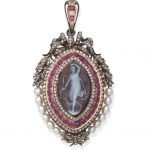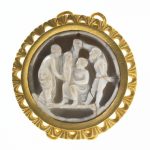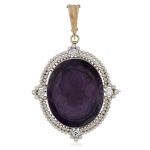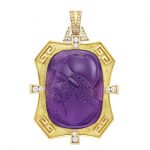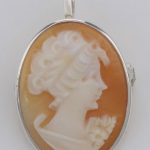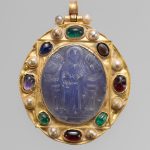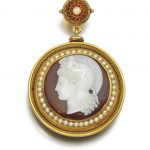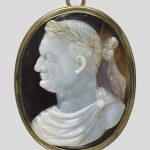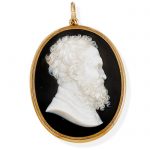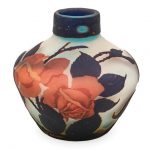Information and history of cameo pendants. The word pendant derives from the Latin word pendere and Old French word pendr, both of which translate to “to hang down”. It comes in the form of a loose-hanging piece of jewellery, generally attached by a small loop to a necklace, which may be known as a “pendant necklace”.
Pendants are still popular forms of mounting cameos. Pendants are among the oldest recorded types of bodily adornment. Stone, shell, pottery, and more perishable materials were used. Ancient Egyptians commonly wore pendants, some shaped like hieroglyphs. Reference: Wikipedia
An agate and gem-set cameo brooch/pendant, circa 1870 The navette-shaped banded agate cameo carved to depict Diana the Huntress, within tiered surrounds of rose-cut diamonds and cushion-shaped rubies, surmounted by a pierced ribbon cresting with a garland surround of rose-cut diamonds and 3.0mm-4.1mm pearls, the suspension loop similarly-set with cushion-shaped diamond accents, the reverse revealing a glazed oval compartment, mounted in silver and gold, pearls untested, length 6.5cm
Sold for £ 8,000 inc. premium at Bonhams in 2018
Gold-mounted sardonyx cameo pendant engraved with the birth of Bacchus; a nymph shows the child to his mother Semele while a satyr looks on. 3rd century
Reference: © The Trustees of the British Museum
ANTIQUE AMETHYST CAMEO SEED PEARL AND DIAMOND BROOCH PENDANT
Designed as an amethyst cameo within a seed pearl and diamond frame, mounted in platinum and gold Metal: 14k yellow gold and platinum Diamonds: 4 round diamonds with approximate total weight of 0.40 carats Stones: 1 oval carved amethyst cameo measuring 30 x 25 x 13.4 mm; approximately 120 seed pearls Size/Dimensions: 4.0 x 4.5 cm Marks: 14 Gross Weight: 22.1 grams Circa 1895
Sold for USD 2750.00 at Christies in 2018
Gold, Amethyst Cameo and Diamond Pendant, Carvin French 18 kt., one cushion-shaped amethyst cameo ap. 35.0 x 25.0 mm., 8 round diamonds ap. .50 ct., small round diamonds, with maker’s mark, ap. 34 dwts. gross.
Amethyst cameo: medium deep purple with medium lavender hues, moderately included, one small white bruise/chip slightly visible to eye, translucent, good polish. Diamonds: H-I-VS, several SI. Good condition. Normal wear, minor scratches on reverse. 2 3/8 x 1 5/8 inches.
Sold for $2,125 (includes buyer’s premium) at Doyle New York in 2018
Italian Hand Carved Cameo Pin / Pendant in Fine Sterling Silver Hand Carved Italian Cameo Pin / Pendant with Sterling Silver frame – The pendant loop is on a hinge and can be positioned up or down depending on whether the item will be worn as a brooch or as a pendant. This beautifully handcarved Italian cameo is surrounded by a simple classic sterling silver frame. cameo pins / brooches and pendants. This brooch or pendant is new and a quality sterling silver antique and collectible reproduction.Metal : Sterling Silver | Stone : Shell Cameo | Shape : Oval | Style : Brooch / Pin / Pendant | Height : 3/4 inch | Width : 5/8 inch | Length : 1 1/8 inches to top of bail | Approximate Weight : 2.1 grams | Clasp : Safety Clasp
Sold for $130 at IRS Liquidations in 2018
Pendant Brooch with Cameo of Enthroned Virgin and Child and Christ Pantokrator
Date:late 1000s–1100s (cameo); 1100s–1300s (mount) Culture:Byzantine Medium:Chalcedony cameo; gold mount with pearls, emeralds, garnets, sapphires, and a sardonyx intaglio
The elaborately carved cameo depicts the enthroned Virgin and Christ Child flanked by archangels, a subject often depicted in the apse of Orthodox churches. On the reverse of the gold case is an image of Christ Pantokrator, which would have been found in the dome of a church. The frame is typical of the Rus’, peoples of the north who had been converted by the Orthodox Christian clergy of Constantinople and who thus prized Byzantine works.
Reference: The Metropolitan Museum of Art
Agate cameo pendant brooch, Luigi Rosi, 1870s Set with a circular agate cameo depicting Minerva, within a seed pearl and open work border in the Etruscan revival style, suspended from a fine rope work and seed pearl floral motif, detachable pendant fitting, signed L. Rosi, Roman assay mark.
Sold for 3,250 GBP at Sothebys in 2018
“Antique” Cameo with Portrait of the Roman Emperor Vespasian
The Roman emperors were popular subjects for cameos (small relief carvings) in antiquity, and this cameo of Vespasian (AD 9-79) imitates that tradition. Cameos of the 16th and 17th centuries imitating Roman carving were often offered to collectors as Roman artifacts. Onyx was favored for cameos because its narrow veins of brown and white color can be carved to set off a white form against a brown background.
Reference: The Walter Art Museum
